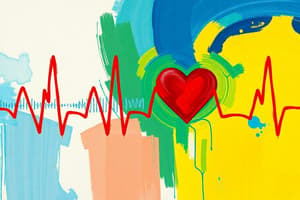Podcast
Questions and Answers
Which ECG characteristic is most commonly associated with myocardial infarction?
Which ECG characteristic is most commonly associated with myocardial infarction?
- ST elevation (correct)
- T wave inversion
- Pathologic Q waves
- ST depression
Which leads are most likely to show inverted T waves in ischemia?
Which leads are most likely to show inverted T waves in ischemia?
- V2-V6 (correct)
- II, III, AVF
- I, AVL
- VI, V2
Which of the following leads is associated with anterior myocardial infarction?
Which of the following leads is associated with anterior myocardial infarction?
- II, III, AVF
- V5, V6 (correct)
- I, AVL
- VI, V2
Which leads are included in a 12-lead ECG (EKG)?
Which leads are included in a 12-lead ECG (EKG)?
What does the PR interval represent in an ECG?
What does the PR interval represent in an ECG?
What does the QT interval represent in an ECG?
What does the QT interval represent in an ECG?
Which leads provide six viewpoints of cardiac activity in the frontal plane?
Which leads provide six viewpoints of cardiac activity in the frontal plane?
What is the normal range of the QRS interval?
What is the normal range of the QRS interval?
How is the heart rate estimated using the box method on an ECG?
How is the heart rate estimated using the box method on an ECG?
Which node is responsible for setting the heart rate if the SA node fails?
Which node is responsible for setting the heart rate if the SA node fails?
What does a narrow QT interval indicate?
What does a narrow QT interval indicate?
What is the normal adult resting heart rate?
What is the normal adult resting heart rate?
Which type of heart block is characterized by prolonged PR interval?
Which type of heart block is characterized by prolonged PR interval?
What is the characteristic feature of right bundle branch block (RBBB) on an ECG?
What is the characteristic feature of right bundle branch block (RBBB) on an ECG?
Which component of the ECG represents atrial depolarization?
Which component of the ECG represents atrial depolarization?
What does the QRS complex represent in an ECG?
What does the QRS complex represent in an ECG?
What does the PR interval signify in an ECG?
What does the PR interval signify in an ECG?
Which leads are used to record the heart's electrical activity in the frontal plane?
Which leads are used to record the heart's electrical activity in the frontal plane?
Which wave represents ventricular repolarization in an ECG?
Which wave represents ventricular repolarization in an ECG?
Which part of the ECG represents the time taken for ventricular depolarization and repolarization?
Which part of the ECG represents the time taken for ventricular depolarization and repolarization?
Which ECG characteristic is typically associated with acute myocardial infarction (MI)?
Which ECG characteristic is typically associated with acute myocardial infarction (MI)?
What does the presence of elevated ST segments on an ECG indicate?
What does the presence of elevated ST segments on an ECG indicate?
Which lead configuration records electrical activity in both the frontal and horizontal planes of the heart during an ECG?
Which lead configuration records electrical activity in both the frontal and horizontal planes of the heart during an ECG?
What is the normal range for the PR interval in an ECG?
What is the normal range for the PR interval in an ECG?
Flashcards are hidden until you start studying
Study Notes
ECG Characteristics
- ST segment elevation is the most commonly associated ECG characteristic with myocardial infarction.
- Leads II, III, and aVF are most likely to show inverted T waves in ischemia.
Leads and ECG Components
- Leads V1-V6 are associated with anterior myocardial infarction.
- A standard 12-lead ECG includes the following leads: I, II, III, aVR, aVL, aVF, V1, V2, V3, V4, V5, and V6.
- The PR interval represents the time taken for atrial depolarization and AV node delay.
- The QT interval represents the time taken for ventricular depolarization and repolarization.
Frontal Plane and Heart Rate
- Leads I, II, III, aVR, aVL, and aVF provide six viewpoints of cardiac activity in the frontal plane.
- The normal range of the QRS interval is 0.08-0.10 seconds.
- The heart rate can be estimated using the box method on an ECG by counting the number of large squares between two successive R-waves.
Heart Block and Bundle Branch Block
- The AV node is responsible for setting the heart rate if the SA node fails.
- A narrow QT interval indicates a shorter time taken for ventricular depolarization and repolarization.
- A prolonged PR interval is characteristic of first-degree heart block.
- The characteristic feature of right bundle branch block (RBBB) on an ECG is a widened S wave in lead I and a widened R wave in lead V1.
ECG Components
- The P wave represents atrial depolarization.
- The QRS complex represents ventricular depolarization.
- The PR interval signifies the time taken for atrial depolarization and AV node delay.
- The T wave represents ventricular repolarization.
Heart Rate and Myocardial Infarction
- The normal adult resting heart rate is 60-100 beats per minute.
- ST segment elevation on an ECG indicates acute myocardial infarction (MI).
- A 12-lead ECG can record electrical activity in both the frontal and horizontal planes of the heart.
Intervals and Ranges
- The normal range for the PR interval is 0.12-0.20 seconds.
Studying That Suits You
Use AI to generate personalized quizzes and flashcards to suit your learning preferences.




